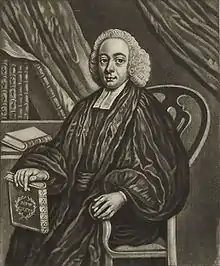Martin Madan | |
|---|---|
 | |
| Born | 1726 |
| Died | 2 May 1790 |
| Nationality | British |
| Occupation | Clergy |
| Known for | Thelyphthora, or A Treatise on Female Ruin |
Martin Madan (1726 – 2 May 1790) was an English barrister, clergyman and writer, known for his contribution to Methodist music, 'The Lock Hospital Collection,' and later controversial views on marriage expressed in his book Thelyphthora.
Life
He was the son of Judith Madan (née Cowper) the poet, and Colonel Martin Madan, and was educated at Westminster School, and at Christ Church, Oxford, where he graduated in 1746. In 1748 he was called to the bar, and for some time lived a very uninhibited life. He was persuaded to change his ways on hearing a sermon by John Wesley. He took holy orders, and was appointed chaplain to the London Lock Hospital. He was closely connected with the Calvinistic Methodist movement supported by the Countess of Huntingdon, and from time to time acted as an itinerant preacher. He was a first cousin of the poet William Cowper, with whom he had some correspondence on religious matters.
In 1767, much adverse comment was aroused by his support of his friend Thomas Haweis in a controversy arising out of the latter's possession of the living of All Saints Church, Aldwincle, Northamptonshire. Madan resigned his chaplainship and retired to Epsom.
He married Jane Hale, daughter of the eminent judge Sir Bernard Hale and his wife Anne Thoresby. They had five children. Jane's portrait was painted by Allan Ramsay. She died in 1794.
Works
In 1760 Martin Madan published for the Lock Hospital the first edition of the collection of Psalms and Hymns Extracted from various Authors. He eventually published 11 editions, his last in 1787.[1] Many of Madan's edits contained in those collections came into general use.[2]
In 1780, Madan raised a storm of opposition by the publication of his Thelyphthora, or A Treatise on Female Ruin, in which he advocated polygamy as the remedy for evils he deplored. His arguments were based mainly on scriptural authority; but his book caused many angry replies. Amongst them was 'Anti-Thelyphthora' by his first cousin, the poet William Cowper, which he published anonymously. A fictional account of this event can be read in The Winner of Sorrow, a 2005 novel about the poet by Brian Lynch.
Nineteen attacks on Madan's treatise are catalogued by Falconer Madan in the Dictionary of National Biography.[3]
Among other works was A New and Literal Translation of Juvenal and Persius (1789).
See also
Notes
- ↑ Hymnology Archive:Martin Madan
- ↑ James Moffatt, Handbook to the Church Hymnary, Oxford University Press, 1927, p. 404
- ↑ Among those, many of which were anonymous were: magazine articles by Samuel Badcock in the Monthly Review; ‘Polygamy Indefensible, two Sermons by John Smith of Nantwich,’ 1780; ‘Polygamy Unscriptural, or two Dialogues, by John Towers,’ 1780 (2nd edit. 1781); ‘Whispers for the Ear of the Author of “Thelyphthora,” by E. B. Greene,’ 1781; ‘A Scriptural Refutation of the Arguments for Polygamy,’ Thomas Haweis, 1781; ‘The Blessings of Polygamy displayed,’ and ‘The Cobler's Letter to the Author of Thelyphthora,’ 1781, both by Sir Richard Hill; ‘Remarks on Polygamy,’ 1781 by Thomas Wills (written at the request of Lady Huntingdon); ‘Anti-Thelyphthora, a Tale in Verse’ by William Cowper, 1781, &c.; ‘A Word to Mr. Madan’ by Henry Moore, 1781 (2nd edit. same year); ‘An Examination of Thelyphthora, by John Palmer,’ 1781; ‘Remarks on Thelyphthora by James Penn’ (1781); and ‘Thoughts on Polygamy’, by James Cookson, 1782. Dictionary of National Biography, v. 35, p. 288-290, Madan, Martin (1726–1790), author of ‘Thelyphthora,’, by Falconer Madan. Published 1893.
External links
- Thelyphthora - Volume 1 of 2
- Thelyphthora - Volume 2 of 2
- Free scores by Martin Madan in the Choral Public Domain Library (ChoralWiki)
- Attribution
This article incorporates text from a publication now in the public domain: Chisholm, Hugh, ed. (1911). "Madan, Martin". Encyclopædia Britannica. Vol. 17 (11th ed.). Cambridge University Press. p. 279.
![]() This article incorporates text from a publication now in the public domain: Lee, Sidney, ed. (1893). "Madan, Martin". Dictionary of National Biography. Vol. 35. London: Smith, Elder & Co.
This article incorporates text from a publication now in the public domain: Lee, Sidney, ed. (1893). "Madan, Martin". Dictionary of National Biography. Vol. 35. London: Smith, Elder & Co.